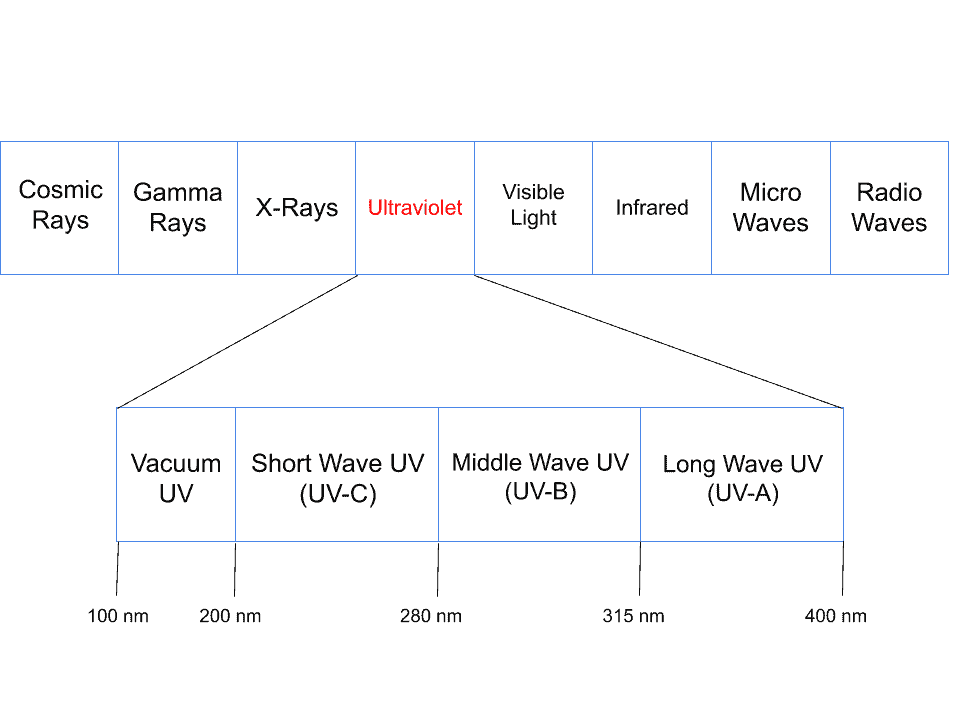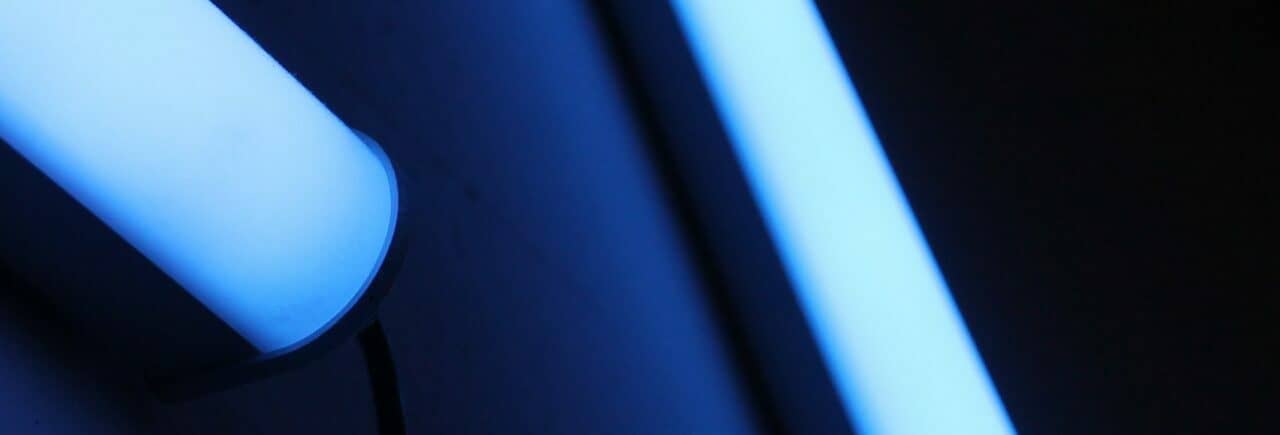One of the more recent innovations that have come to air purifiers and air scrubbers is the use of Ultraviolet (UV) light to purify the air.
UV light has been around for several years, and it is used to disinfect the air and different surfaces and remove bacteria and other harmful substances from water. They have also been used in hospitals to fight Covid.
There has always been a debate regarding their effectiveness and safety concerns. We have prepared this article to help you understand how UV light air filters work and answer the question: What does UV light do in an air purifier?
Table of Contents
How UV Light Works To Clean The Air
Ultraviolet light is a form of electromagnetic wave invisible to the naked eye. UV light can cause cell death in microorganisms, making it useful for destroying pathogens in the air.
UV-C vs UVGI
UV-C is a category of ultraviolet light that includes shortwave UV, emitted at a wavelength between 200 to 280 nanometers.
This spectrum is emitted by the sun and blocked by the ozone layer.It also has germicidal properties.
UVGI stands for Ultraviolet Germicidal Irradiation. UVGI refers to the use of UV light to purify the air. This includes the use of UV-C light, but may also include other bands of UV light like the use of UV-A which we’ll describe below.
Different Kinds of UV Light
UV-C isn’t the only type of ultraviolet light available. The entire spectrum of UV light is divided into UV-A, UV-B, and UV-C. Each category has a different wavelength range.
UV-A: Ultraviolet A is also known as long-wave UV light, and it exists in wavelengths between 315 nm to 399 nm. The sun emits UVA, and the ozone layer lets it through. It also has slight germicidal properties.
UV-B: Ultraviolet B is also called medium-wave UV light, and it exists in wavelengths between 280 nm to 315 nm. The ozone layer only absorbs some of it from the sun. It can cause sunburns and has some germicidal properties.
UV-C: Ultraviolet C is shortwave UV light, and it exists in wavelengths between 200 nm to 280 nm. The ozone layer and atmosphere fully absorbs UV-C. It has the strongest germicidal properties amongst UV light.
Vacuum UV (VUV): Vacuum UV exists in the wavelengths between 100 nm and 200 nm. It is used in spectroscopy and also has some slight germicidal properties.

How Effective is UV Light?
This is a difficult question to answer for many reasons. There are many factors that influence the effectiveness of UV Light in purifying the air such as :
Target: What are you attempting to eliminate? This could be a microorganism like a fungus (mold, mildew) or bacteria. Or maybe you’re more concerned with viruses or eliminating odor from smoke.
Wavelength: What wavelength of light is being used?
As mentioned above UV-C light is comprised of the wavelength between 200 and 280 nanometers. However, even in this range, its effectiveness against microorganisms vary with the most lethal dose against microorganisms being the wavelength of 262 nanometers.
Intensity: What is the intensity of the light at the point of the target?
Light gives off energy and this energy can be calculated as watts per meter squared. Different targets require different amounts of energy in order to inactivate them. Larger light sources can generate more energy.
Duration: How long has the pathogen been exposed to the light?
As mentioned above different targets have different energy thresholds. In order to meet those thresholds the target must be exposed to the light source for a sufficient amount of time.
Distance: How far away is the target from the light source?
The distance from the light source to the target affects the amount of energy the target receives. Take the sun for example. On a summer day you feel the light as a warm glow on your skin, but if you were right next to the sun, you would combust as the energy is much stronger at the source.
Now, assuming the wavelength, intensity, duration, and distance are sufficient, the question is what can UV light eliminate?
UV-C Light vs Tobacco Smoke Odor
UV light with sufficient intensity can break the chemical bonds in tar and nicotine which should help reduce smoke odors. However, a more effective solution would be to use an ozone generator.
UV-C Light vs Covid-19
UV light can deactivate viruses including covid-19. The Nature journal published a study where they showed UV light can be used to deactivate covid-19.
UV-C Light vs Microorganisms
UV light has been shown to cause cell death in microorganisms such as mold, mildew, and different bacterias. It has also been shown to inactivate viruses.
Not all microorganisms are created equal, some are more susceptible to UV light than others. For instance, in general fungus, like mold and mildew, are more resistant to UV-C than bacteria.
UV Light vs VOCs
Volatile organic compounds (VOCs) refer to gases emitted by liquids or solids, such as formaldehyde in molded plastics. UV light alone doesn’t kill VOCs, but when used as part of a process known as Photocatalytic Oxidation, it can eliminate VOCs from the surrounding air.
UV Light vs Allergens
UV light is effective against biological allergens like mold, mildew, and some types of pollen. It will not eliminate dust.
It’s important to note that while UV-C light will deactivate these allergens meaning they will not replicate, the deactivated form is still capable of causing allergies so UV light alone is not enough to prevent allergies. UV light should be used alongside a quality air purifier.
How Quickly Does UV Light Work?
The time taken for UV light to kill pathogens in the air depends on several factors, such as its wavelength, intensity, exposure time, and the distance from the light source.
In order to give an estimate for the time it takes UV light to deactivate contaminants we’ll use the same setup given in the following covid experiment to extrapolate to other targets.
In the Covid experiment below the researchers used a 254nm UV-C light source with the intensity of light on the target being .849 mW/cm^2.
How Quickly Does UV-C Light Work Against Covid?
We’ll refer to a study that was conducted to evaluate the efficiency of UV-C light against Covid-19. In the study, a 254nm UV-C light source was used with the intensity of light on the target being .849 mW/cm^2.
For a point of comparison, this handheld UV wand claims an intensity of .61 mW/cm^2 at a distance of 1 inch from the target. Most air scrubbers that use UV-C light appear to have a light source of similar size.
In the study they were able to reduce Covid-19 to undetectable levels in about 9 seconds.
How Quickly Does UV-C Light Work Against Bacteria?
As mentioned above different bacteria have different energy thresholds for deactivation.
Ultraviolet.com mentions that E.coli requires 6.60 mJ/cm^2 of UV energy before deactivation. Using the set up from the covid study we would find that it would take about 7.7 seconds.
How Quickly Does UV-C Light Work Against Fungus?
Americanultraviolet.com provides a useful chart of the different amounts of UVC energy needed to deactivate different types of mold.
One of the most common molds, penicillin expansum, takes 3000 microwatts/cm^2 for 90% efficacy and 22000 microwatts/cm^2 for 99.9 efficacy.
Again, if we use the covid study setup we can convert our .849 mW/cm^2 light intensity to 849 microwatts/cm^2. Using this intensity we find that it would take 3.5 seconds for 90% efficacy and ~ 26 seconds for 99.9 efficacy.
Do UV Air Scrubbers Work?
Now for the million dollar question, how effective are air scrubbers that use UV-C light?
Unfortunately, this is currently impossible to answer with 100% accuracy for a few reasons:
1. We’ve reviewed many air scrubbers that use UV-C light, but not one of them mention the specifics in terms of the wavelength of UV-C light or the intensity.
2. None of the air scrubbers We’ve come across have been independently tested to assess the efficacy of their UV-C light filter.
So unfortunately we’ll have to make an educated guess.
Let’s pretend we have an air scrubber that is about 2ft long, a common size, with a CFM of 500, again a common CFM. That means the air scrubber is moving air at the speed of 500 cubic feet per minute.
With these measurements we can calculate a rough estimate that air only spends about half a second in the air scrubber (2ft/500ft * 60 seconds) with exposure to the UV-C light.
Based on the time that it takes UV-C light to deactivate different pathogens we can conclude that it is unlikely that the UV-C light used in air scrubbers is effective.
Do UV-C Lights Produce Ozone?
No, UV-C light does not produce ozone.
Actually, UV light between the wavelengths 240-315nm destroys ozone. This includes UV-C light between the wavelengths 240-280nm.
Ozone can be damaging to the lungs when inhaled so it’s a good thing that UV-C light doesn’t produce it.
Are Air Scrubbers That Use UV-C Light Safe?
Even though UV-C light doesn’t produce ozone that doesn’t necessarily mean that it is safe.
UV-C light can be damaging to the eyes and skin.
However, that is with direct exposure, luckily the UV-C lights used in air scrubbers are usually located inside of the unit, behind the filters. UV-C light doesn’t pass through material like glass and plastic (common HEPA filter materials) so there should be little to no UV-C exposure outside of the air scrubber unit.
Is a UV-C air scrubber worth it?
As we mentioned above, it is unlikely that the UV-C light used in air scrubbers is effective. However, there are many air scrubbers with great features including portability, strength, helpful indicator lights, and more.
If a quality air scrubber also happens to use UV-C light there isn’t any harm in using one as long as the air scrubber is used properly. If you’re looking for a great air scrubber you can check out our list of the best air scrubbers, a few of which include UV-C light filters.

I do the research so you don't have to.

